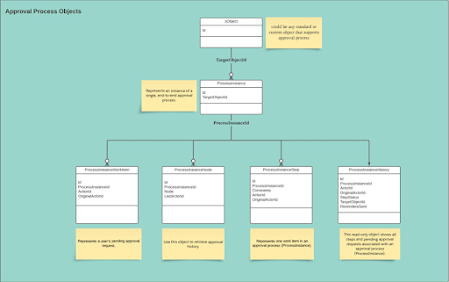"Understanding the Robust Data Security Model in Salesforce"
Salesforce provides a comprehensive and flexible data
security model to secure data at different levels. Salesforce also
provides sharing tools to open up and allow secure access to data based on
business needs.
There are three key constructs related to data in Salesforce: Objects, Fields and Records.
- Objects are similar to tables in databases.
- Fields are similar to columns of the table.
- Records are similar to rows of data inside the table.
Layer 1: Object-level Security
Object-level access can be managed through two
configurations - Profiles and Permission Sets.
Profiles
Assigning a user a profile is compulsory, as this is the place
where you configure other things like page layout assignments or login IP
restrictions. However, for object and field security setup, configure profiles
for minimum access and use permission sets to add permissions.
Permission sets
Permission sets are more flexible. In contrast to profiles, you can add multiple permission sets to a given user. This gives you much more flexibility at the time of designing your security model, as functionality can be grouped in more granular ways. When only using profiles, you needed to group all the object and field permissions in a single profile, for instance for a concrete job role, as sales exec. With permission sets you can have different permission sets representing the different tasks that that a sales exec performs: manage leads, approve opportunities, etc. and add or remove smaller chunks of permissions to a user at any time.
Layer 2: Field-level Security
- Even if a user has access to objects, he/she still needs access to individual fields of each object. In Salesforce, profiles and permission sets also control field-level access. An admin can provide read and write permissions for individual fields.
- An admin can also set a field to hidden, completely hiding removing access to the field to from that user. When you hide a field with field-level security, the field won't be accessible through any entry points (for instance via API).
Layer 3: Record-level Security
- Record-level security is often referred to as the Salesforce sharing model, or just simply "record sharing" or "sharing".
- Salesforce provides five ways to share records with others and access others' records. You start by configuring org-wide defaults, to lock down your data to the most restrictive level. Then you use the other record-level security tools to grant additional access to selected users when needed.
Types of Record-level Security
1:-Organization- Wide Sharing Defaults
2:- Role Hierarchies
3:- Sharing Rules
• Ownership-based
Sharing Rule
•Criteria-based
Sharing Rule
4:- Manual Sharing
5:- Apex Managed Sharing
Organization-Wide Sharing Defaults
1.
In Salesforce, records have a field called
"Ownerld" that points to a real user. Owners of records are usually
people who created the record and have full CRUD (create, read, update, delete)
access to it.
2. Organization-wide defaults (OWD) control the default behavior of how every record of a given object (for example, Accounts) is accessed by users who do not own the record.
Role Hierarchies
1.
Typically in an organization, different job
roles have different record access requirements. Normally job roles are sorted
in a hierarchical way: users with a higher role should have access to records
to which users in lower roles have access.
2.
Note that a role hierarchy rarely maps to an org
chart. It really maps hierarchies of data access. Salesforce provides an easy
way to share records with managers and represent a role hierarchy. To use this
sharing rule, an admin must first add the user to a role and grant access.
Sharing Rules
Hierarchy-based sharing only works for sharing upward and in
a vertical direction. What if we want to share laterally? For example, what if
we want to share records that a user owns with his/her peers in the same team?
This is where sharing rules come in. Sharing rules provides a way to share
records laterally and in an ad-hoc fashion via public groups.
Let's look into the details.
1. Ownership-based Sharing Rule
Ownership-based sharing rules let admins share records based
on role, role-and subordinate, and public group ownership.
2. Criteria-based Sharing Rule
Criteria-based sharing rules let users access records based
on the value of a field in a record, irrespective of who owns the record.
Manual Sharing
Manual sharing provides a mechanism to share individual
records with others. This permission is accessed through the Sharing button on
the record details page, and lets end-users share individual record with
others.
Please Note: This is only available if the OWD is private or
public read-only because otherwise (say public read/ write), you wouldn't need
it.
Best practices for data security in
Salesforce:
- Use strong passwords and enable multi-factor authentication for all users.
- Limit access to data and features based on user roles and permissions.
- Encrypt sensitive data at rest and in transit.
- Regularly monitor and audit user activity, data changes, and system events.
- Keep the Salesforce platform and all integrated applications up to date with the latest security patches and updates.
Conclusion:
In conclusion, Salesforce's data security model offers a robust
and comprehensive set of features to protect against unauthorized access, data
breaches, and cyber threats. By implementing best practices and adhering to
industry standards and regulations, organizations can ensure that their data
and customer information remains secure and protected. As the Salesforce
platform evolves and new security threats emerge, it is essential to stay up to
date with the latest security features, updates, and best practices.











.png)

.webp)
Comments
Post a Comment